All Articles
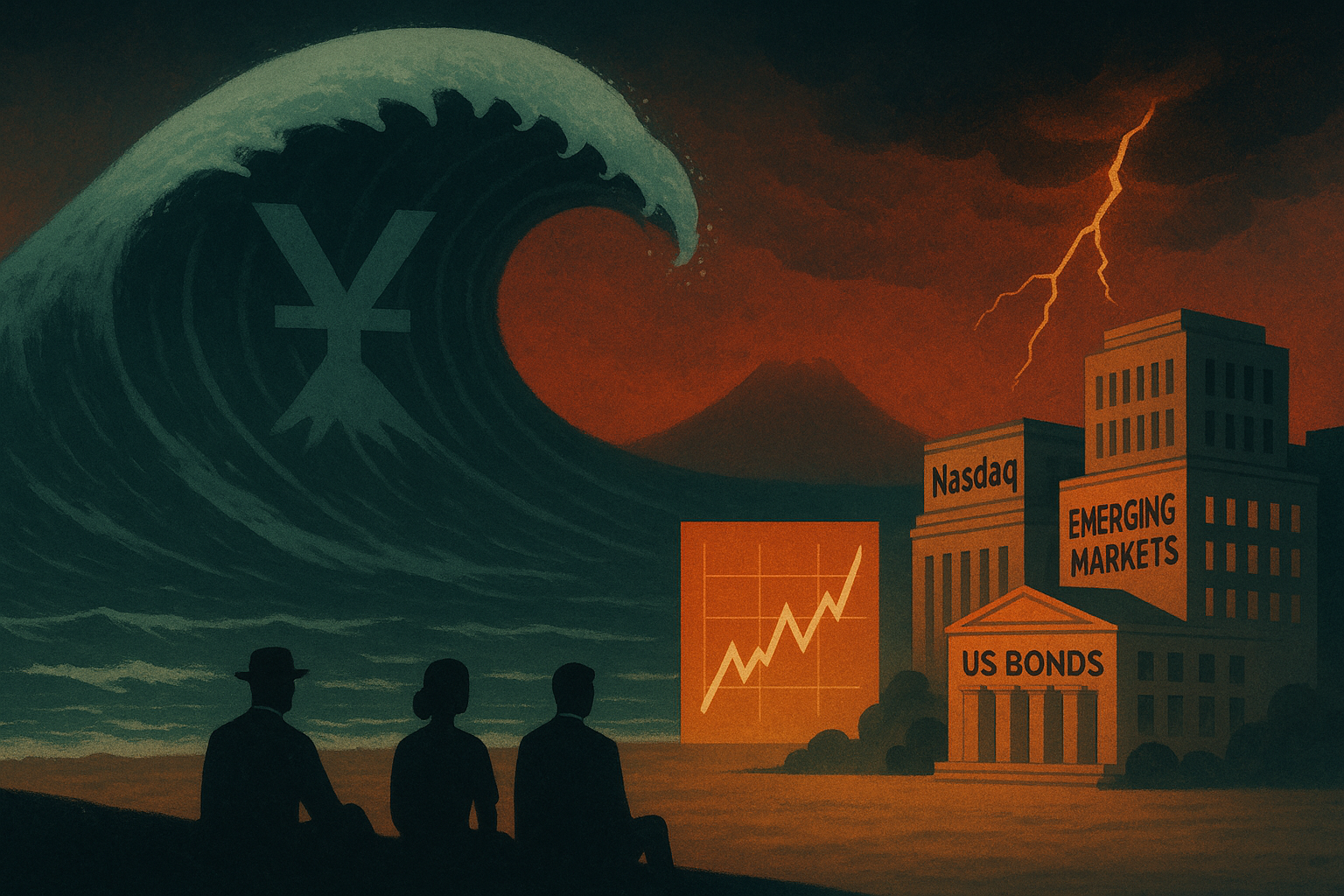
The Hidden Trigger: How Japan's Carry Trade Bubble Could Unleash the Next Global Shock
Japan's transition from the world's primary source of cheap funding to monetary normalization represents the most significant underpriced tail risk in global financial markets. After three decades of ultra-accommodative policy that transformed the yen into the foundation of global leverage, the Bank of Japan (BOJ) faces mounting pressure to normalize rates amid persistent inflation above target and political backlash against currency weakness. This policy pivot threatens to trigger an unwinding of carry trade positions estimated between $1-4 trillion, with the potential to destabilize markets far beyond traditional currency channels. The systemic importance of this risk stems from three interconnected factors. First, Japan's unique position as the world's largest creditor nation with $3.4 trillion in net foreign assets means that capital repatriation would drain liquidity from global markets on an unprecedented scale. Second, the multi decade stability of Japan's zero-rate policy has created deeply embedded market structures and risk models that systematically underestimate the probability and impact of a regime change. Third, modern financial markets have created hidden linkages between yen funding and seemingly unrelated asset classes, from U.S. technology stocks to emerging market debt, amplifying contagion channels. The August 2024 episode provided a preview of this vulnerability. A modest 15 basis point BOJ rate hike triggered a 10% yen appreciation, a 12% Nikkei plunge, and synchronized selling across global risk assets. Critically, this unwinding was only partial speculative positioning data suggests 50-60% of positions remained intact, leaving substantial dry powder for future volatility. Unlike the Swiss franc, which serves a niche role constrained by active central bank intervention and limited market depth, the yen's systemic importance makes its normalization a global event that no single policy authority can control
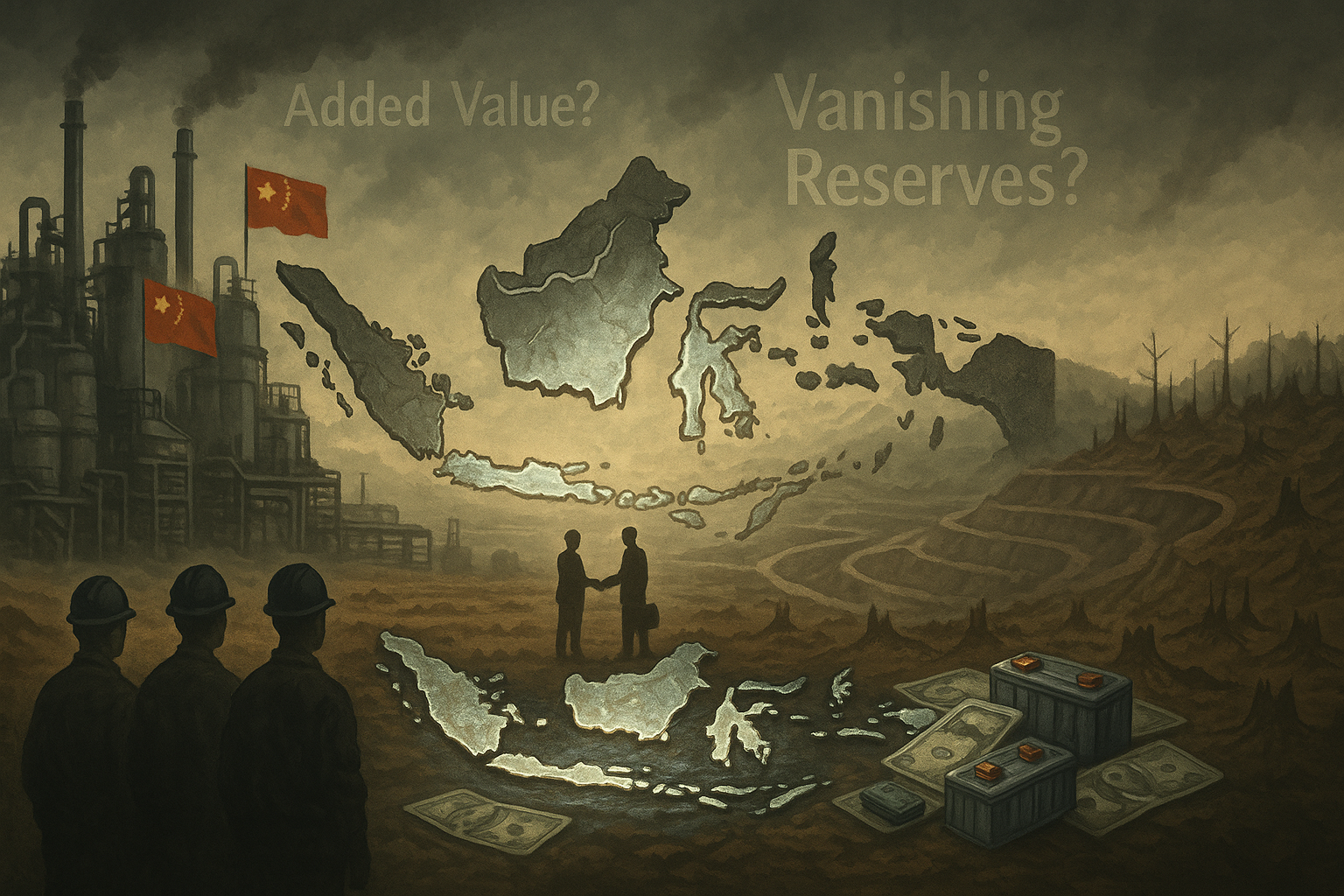
Indonesia's Downstream Nickel Strategy: Battery Supply Chain Sovereignty or Resource Trap?
The article critically examines Indonesia’s ambitious downstream nickel strategy, which aims to transform the country from a raw material exporter into a key player in the global electric vehicle and battery supply chain. While Indonesia has significantly increased its nickel export value and attracted massive foreign investment particularly from China, the strategy faces major challenges, including environmental degradation, technological dependency, inequitable benefit distribution, and potential resource depletion. The analysis raises the question of whether Indonesia is truly achieving economic sovereignty or falling into a resource trap, urging a shift toward cleaner technologies, stronger domestic capacity, and more equitable, sustainable industrial development.

No One Wins Forever: Unpacking Game Theory and the Real Rules of Financial Competition
This article explores how game theory reveals the hidden logic behind competition in modern markets, showing that no business, no matter how dominant can win forever. Using Southeast Asian case studies like e-commerce price wars and ride-hailing battles, it explains how every strategic move triggers reactions, leading to cycles of adaptation, temporary advantage, and eventual equilibrium. The article unpacks practical concepts like the Red Queen Effect, Nash Equilibrium, the Prisoner’s Dilemma, first-mover advantage, and kingmaker dynamics offering actionable insights for investors, entrepreneurs, and decision-makers on how to survive and thrive in an ever-shifting business landscape where resilience, adaptation, and strategic thinking matter more than any single “winning” move.

The Role of Liquefied Natural Gas in the Global Energy Transition
This article provides a comprehensive analysis of the evolving role of Liquefied Natural Gas (LNG) in the global energy transition, highlighting its dual nature as both an enabler of energy security and a source of climate risk. LNG has emerged as a pivotal “bridge fuel,” supporting nations in diversifying their energy mix and stabilizing grids as they integrate more renewables, especially amid geopolitical upheavals like the Russia-Ukraine war. The article details the technological, geopolitical, and financial dynamics driving LNG demand, with a special focus on Europe’s pivot away from Russian pipeline gas and Southeast Asia’s surging consumption. While LNG offers operational flexibility and emits less CO₂ than coal or oil, its climate benefits are undermined by methane leakage and the risk of locking in long-term fossil fuel dependence through expensive infrastructure investments. The analysis concludes that LNG’s future as a sustainable energy solution hinges on aggressive methane mitigation, responsible investment, and alignment with Environmental, Social, and Governance (ESG) standards otherwise, its continued expansion may impede global decarbonization goals rather than facilitate them.

Navigating Turbulence: Trump's Tariff Volatility Meets the Digital Dollar Revolution
This article analyzes the paradoxical financial environment of 2025, where erratic U.S. tariff policies under President Trump have triggered significant market volatility and disrupted global trade, especially impacting Asian economies. Simultaneously, the advancement of the GENIUS Act signals a transformative push toward regulated Treasury-backed stablecoins, promising to reinforce U.S. dollar dominance through digital currency innovation. This dual dynamic creates a complex interplay of risks and opportunities, urging Asian policymakers and investors to strategically navigate tariff-induced uncertainty while leveraging emerging digital financial technologies to foster economic resilience, financial inclusion, and technological leadership in a rapidly evolving global monetary landscape.

Beyond Marketplaces: Navigating the Future of E-commerce Amid High Fees and Talent Inflation
This article is a strategic analysis of Southeast Asia’s shifting e-commerce landscape, focusing on the growing challenges faced by SMEs and startups due to rising marketplace fees and inflated tech talent costs. The article critically examines how platforms like Shopee, Tokopedia, and Amazon have evolved from enablers into margin-compressing ecosystems, while also exposing the inefficiencies of overfunded startup cultures driven by unsustainable hiring practices. In response, it outlines actionable strategies such as embracing Direct-to-Consumer (D2C) models, adopting omnichannel approaches, optimizing cost structures, and implementing competency-based recruitment. With projections showing Southeast Asia’s e-commerce GMV doubling by 2030, the article urges businesses to rethink their dependence on marketplaces, reclaim brand autonomy, and position themselves for long-term growth through agility, efficiency, and customer-centric innovation.

This article analyzes the European Union’s Carbon Border Adjustment Mechanism (CBAM), a new policy that imposes a carbon price on imports of carbon-intensive goods to the EU, aiming to prevent carbon leakage and promote global decarbonization. Focusing on the implications for ASEAN countries—which are major exporters of energy and industrial goods to the EU—the article explains how CBAM could impact trade competitiveness, supply chains, and national carbon policies, particularly for sectors like steel, aluminum, cement, and energy exports. It highlights the need for ASEAN nations to enhance their carbon pricing mechanisms, monitoring and reporting systems, and to invest in greener technologies to remain competitive. While CBAM poses risks such as increased costs and administrative burdens, it also presents opportunities for ASEAN to accelerate its green transition and industrial modernization, provided they adapt proactively both domestically and in regional cooperation.

From Tariffs to Rate Cuts: How the US-China Trade Reset Shapes Global Markets
This article analyzes the 2025 trade truce between the U.S. and China reducing tariffs to 30% and 10% respectively and its broader implications for global markets, monetary policy, and investor behavior. While the de-escalation offers temporary relief, the paper argues that underlying economic fragility persists, with sluggish growth forecasts, sticky inflation, and a growing disconnect between market optimism and fundamentals. It further explores how reduced expectations for Federal Reserve rate cuts (from 75bps to ~56bps) reflect this uncertainty, and provides scenario-based outlooks for the remainder of 2025, offering strategic investment insights amidst a complex, policy-driven environment.

The Debt-Driven Storm: Applying Ray Dalio's Crisis Blueprint to Navigate the 2025 Market Crossroads
In a complex world facing persistent inflation, escalating geopolitical tensions, and increasingly fragile credit systems, Ray Dalio's comprehensive macro frameworks offer invaluable insights for anticipating potential economic paths. By applying Dalio's theories on debt cycles, the economic machine, and shifting world orders, this analysis provides strategic perspectives on the 2025 market landscape and delivers actionable guidance for investors, policymakers, and thought leaders navigating through unprecedented uncertainty.
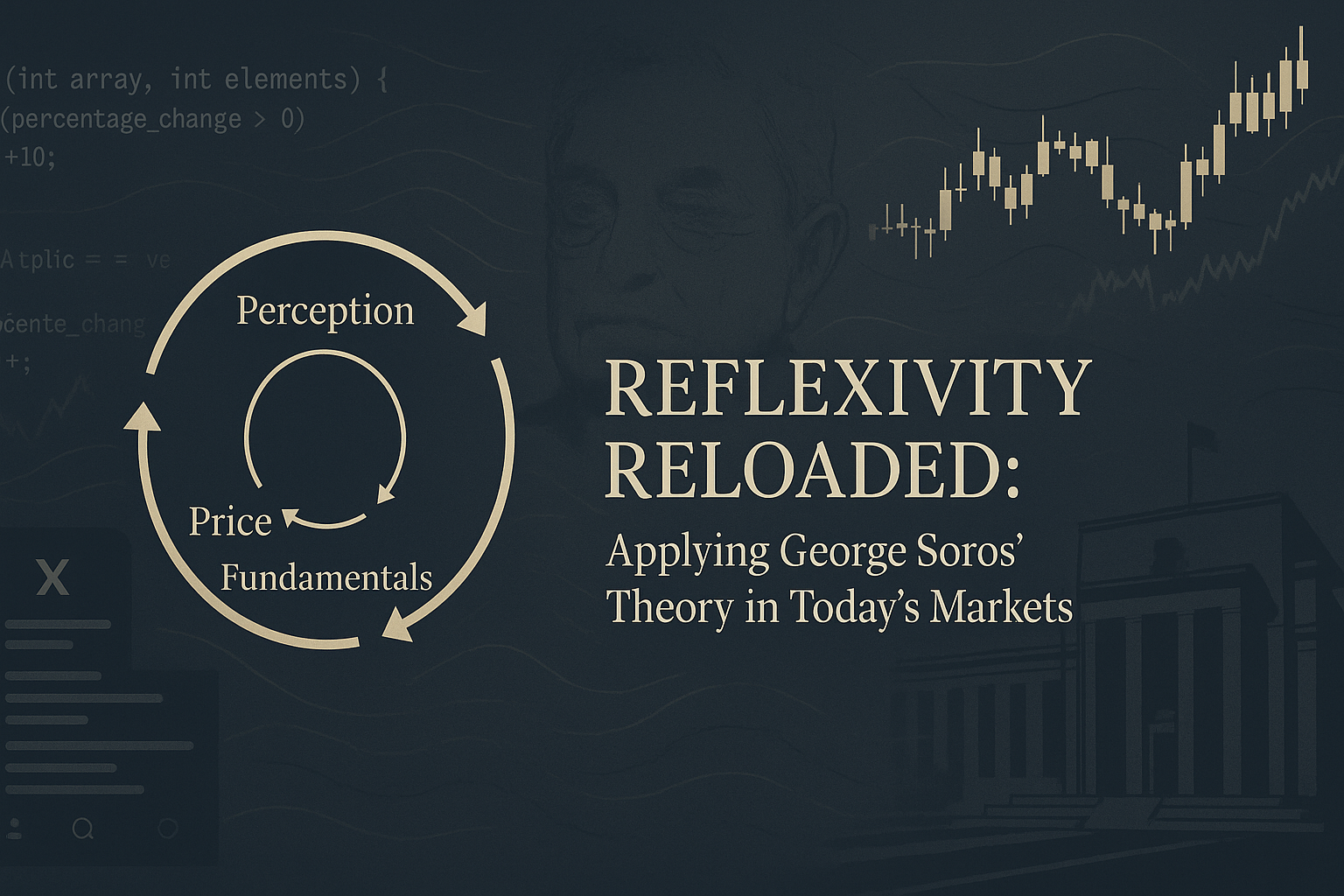
REFLEXIVITY RELOADED: APPLYING GEORGE SOROS' THEORY IN TODAY'S MARKETS
This article revisits George Soros’s theory of reflexivity, which argues that market participants’ perceptions influence prices, and those prices, in turn, reshape economic fundamentals, forming a feedback loop. Far from outdated, the theory proves crucial in today’s volatile markets dominated by algorithmic trading, social media narratives, and institutional herding. The piece examines how fallibility, reflexivity, and perception-driven cycles create boom-bust patterns, as seen in recent events like the meme stock frenzy and the ongoing AI investment cycle. It introduces a Reflexive Investor’s Toolkit for mapping market narratives, spotting opportunities, and detecting risks. Finally, it expands the concept beyond finance into monetary policy, consumer confidence, and innovation ecosystems arguing that reflexivity provides a powerful framework for navigating modern uncertainty and complexity in both markets and policymaking.

Mining Industry Regulatory Compliance: Navigating Global Standards
This article provides a comprehensive examination of the mining sector's regulatory landscape, emphasizing the need for robust environmental, social, and governance (ESG) compliance. It discusses key regulatory areas such as waste management, water use, air quality, worker safety, and community engagement, highlighting the risks of non-compliance and the importance of maintaining a social license to operate. It explores global and national standards, challenges in ESG reporting, and the increasing role of technology in monitoring and improving safety and sustainability. The article concludes by urging mining companies to go beyond compliance through green mining, innovation, and proactive stakeholder engagement to ensure long-term sustainability and social responsibility.

Shale Gas Revolution: Environmental Impact and Economic Benefits
This article explores how the rise of shale gas unlocked through technologies like hydraulic fracturing and horizontal drilling has reshaped the global energy landscape. It highlights the economic benefits such as energy independence, job creation, and lower energy prices, especially in the United States. However, the article also critically examines the environmental downsides, including groundwater contamination, methane emissions, and induced seismicity. It emphasizes the need for technological innovation, regulatory frameworks, and sustainable practices to balance economic gains with environmental protection. The piece concludes that while shale gas can serve as a transitional energy source, its long-term role depends on global decarbonization efforts and energy policy evolution.

Is Traditional Monetary Policy Dead? Navigating Liquidity Traps in a Post-Crisis World
This article critically examines the diminishing effectiveness of traditional monetary policy tools particularly interest rate cuts in the face of persistent economic stagnation and structural challenges following the 2008 Global Financial Crisis. It explores the emergence of liquidity traps, where near-zero interest rates fail to stimulate investment or consumption, and introduces the concept of shadow rates as a more accurate reflection of monetary accommodation under unconventional policy regimes. The piece discusses the rise and limitations of quantitative easing (QE), highlighting its unequal impacts on asset prices versus the real economy. It contrasts the policy responses of the U.S. Federal Reserve and Bank Indonesia, emphasizing the need for tailored, pragmatic strategies in emerging markets. The article concludes by advocating for a multidimensional monetary policy framework that incorporates tools like yield curve control, central bank digital currencies (CBDCs), and closer fiscal-monetary coordination, arguing that adaptation not abandonment of central banking is essential in the post-crisis world.

The Strategic Importance of Critical Minerals in Clean Energy
This article explores the crucial role of critical minerals such as lithium, cobalt, nickel, graphite, and rare earth elements in enabling the global transition to clean energy systems. These minerals are essential components for technologies like electric vehicles (EVs), wind turbines, solar panels, and energy storage solutions, which are key to achieving carbon neutrality and reducing greenhouse gas emissions. The article highlights that while these minerals are vital for sustainable energy technologies, their supply chains are vulnerable due to geographic concentration, geopolitical risks, price volatility, and environmental concerns associated with mining and processing.

Offshore Vessel Decommissioning: Challenges and Opportunities
This article discusses the challenges and opportunities in the process of offshore vessel decommissioning, which refers to the retirement, dismantling, and disposal of ships and offshore infrastructure that have reached the end of their operational life in the oil and gas industry. Decommissioning is not merely about dismantling or removing old structures, it is a critical phase in the lifecycle of offshore assets that involves a wide range of considerations, including technical, economic, regulatory, environmental, and social aspects.
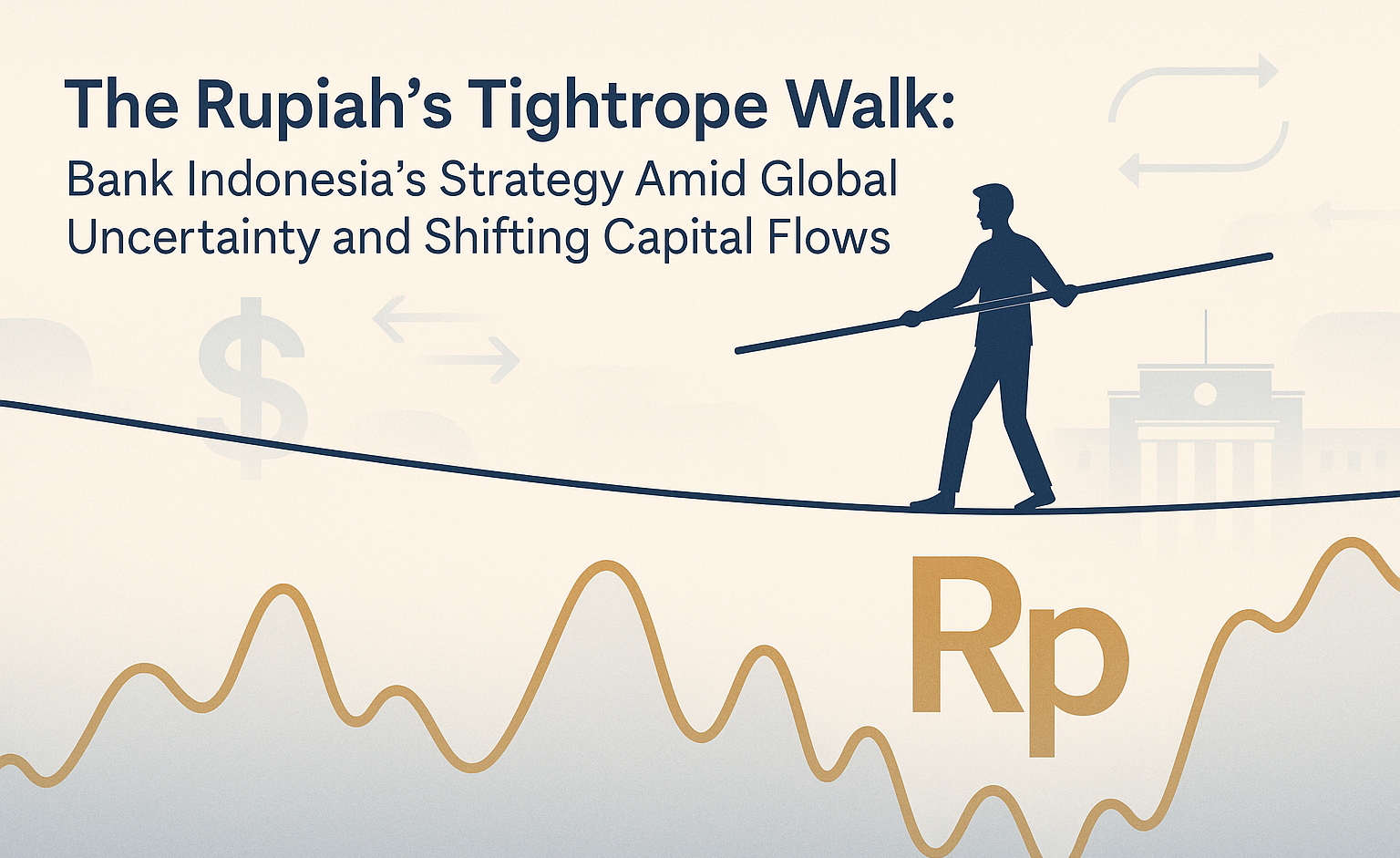
This provides an analysis of Bank Indonesia's strategic response to complex global conditions in early 2025, highlighting its priority on Rupiah stability amid uncertainties from U.S. monetary policy shifts, escalating trade tensions, and volatile capital flows. Bank Indonesia maintained its benchmark rate (BI-7DRRR) at 5.75% since January 2025, signaling a cautious approach focused primarily on exchange rate stability. Despite proactive interventions, the Rupiah faced persistent depreciation pressure driven by portfolio outflows of USD 2.8 billion amid global market volatility linked to U.S. trade policies. Interestingly, foreign exchange reserves reached a record high (USD 157.1 billion), largely supported by government loans and BI’s issuance of market instruments like SRBI and SVBI. Nonetheless, Indonesia's external position showed strains, with a widening current account deficit in 2024, though balanced by financial inflows. Inflation remained subdued domestically, but BI adjusted its growth forecast downward for 2025 due to global uncertainties, particularly from U.S.-China tensions. Looking ahead, BI’s policy will remain data-dependent, closely monitoring Rupiah stability, global market conditions, and capital flow dynamics.

The API Economy: Business Models in the Composable Enterprise
The API economy represents a fundamental shift in how businesses create, deliver, and capture value in the digital age, generating over $1 trillion in market value through programmable interfaces that enable modular architectures and ecosystem driven growth. With 83% of internet traffic now flowing through APIs and the API management market projected to grow from $7.6 billion in 2024 to $16.9 billion by 2029 (CAGR ~17%), organizations face a strategic imperative to embrace API driven models. API-first companies command 32% higher valuation multiples than industry peers, while composable enterprises achieve 30% faster product launches and 40% lower IT costs through API-driven modularity. This analysis examines the architectural foundations, monetization strategies, governance frameworks, and future directions of API business models. As major platforms process trillions in transaction value annually and regulatory frameworks increasingly mandate API access, API strategy has evolved from technical consideration to competitive differentiator with enterprises lagging in API maturity risking 40% higher digital transformation costs compared to leaders.
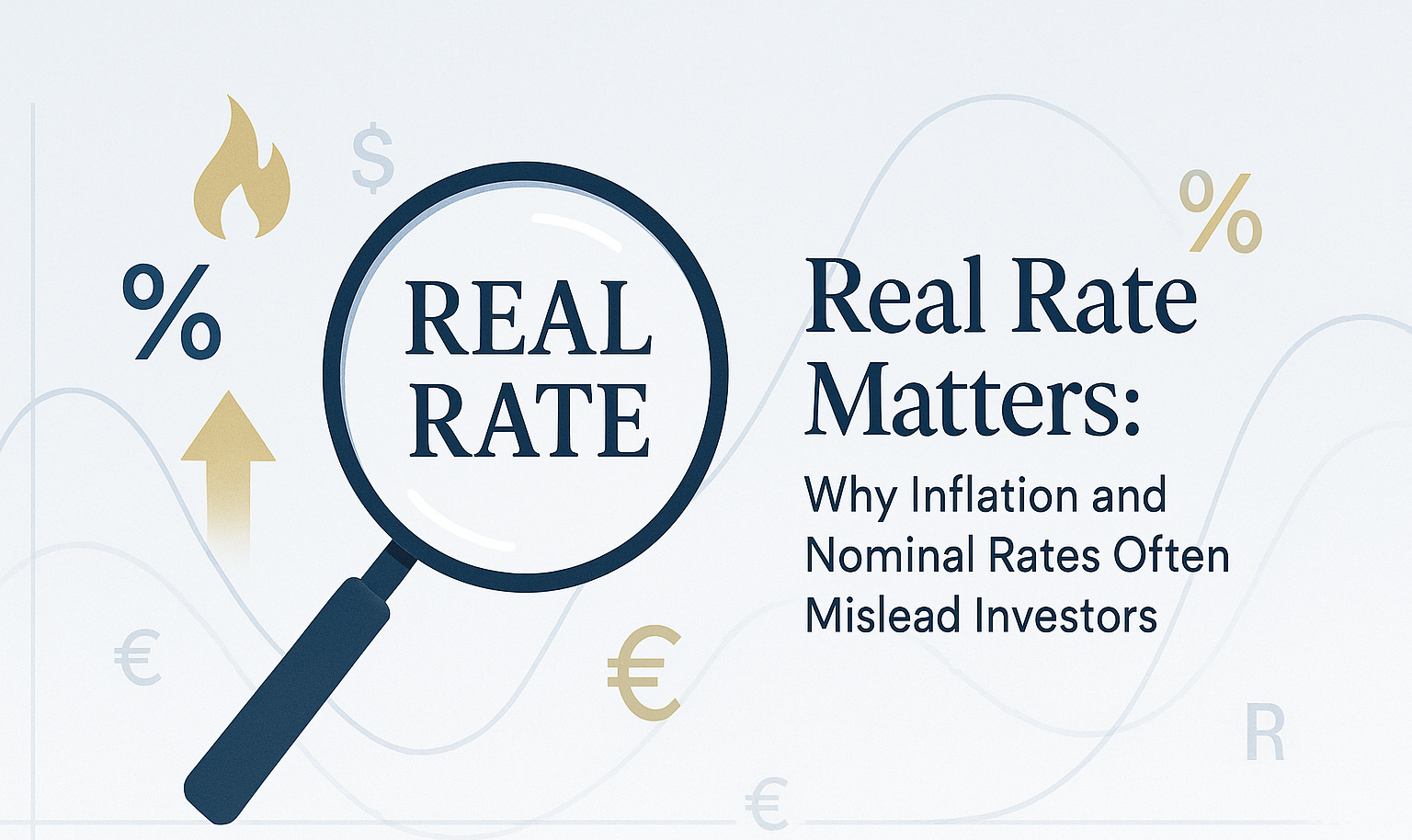
Real Rate Matters: Why Inflation and Nominal Rates Often Mislead Investors
This article highlights why focusing on nominal interest rates alone can lead to major investment mistakes and policy errors. The real interest rate calculated by subtracting inflation from nominal rates offers a more accurate measure of monetary conditions and true investment returns. Drawing from historical crises in the US, Turkey, and Indonesia, the research shows how negative real rates can fuel inflation, trigger capital flight, and destabilize currencies, even when nominal rates appear high. The Fisher Equation serves as the key framework for understanding this relationship, emphasizing the role of inflation expectations and central bank credibility. As of 2025, global real rate conditions remain highly uneven across regions, shaping capital flows, currency stability, and asset valuations. The article outlines three potential future scenarios through 2030 from successful disinflation to persistent inflation shocks and policy mistakes. Understanding real rates is critical for informed portfolio decisions across bonds, equities, currencies, and commodities. This piece provides investors and policymakers with the insights needed to navigate monetary uncertainty and avoid the trap of headline nominal rates.
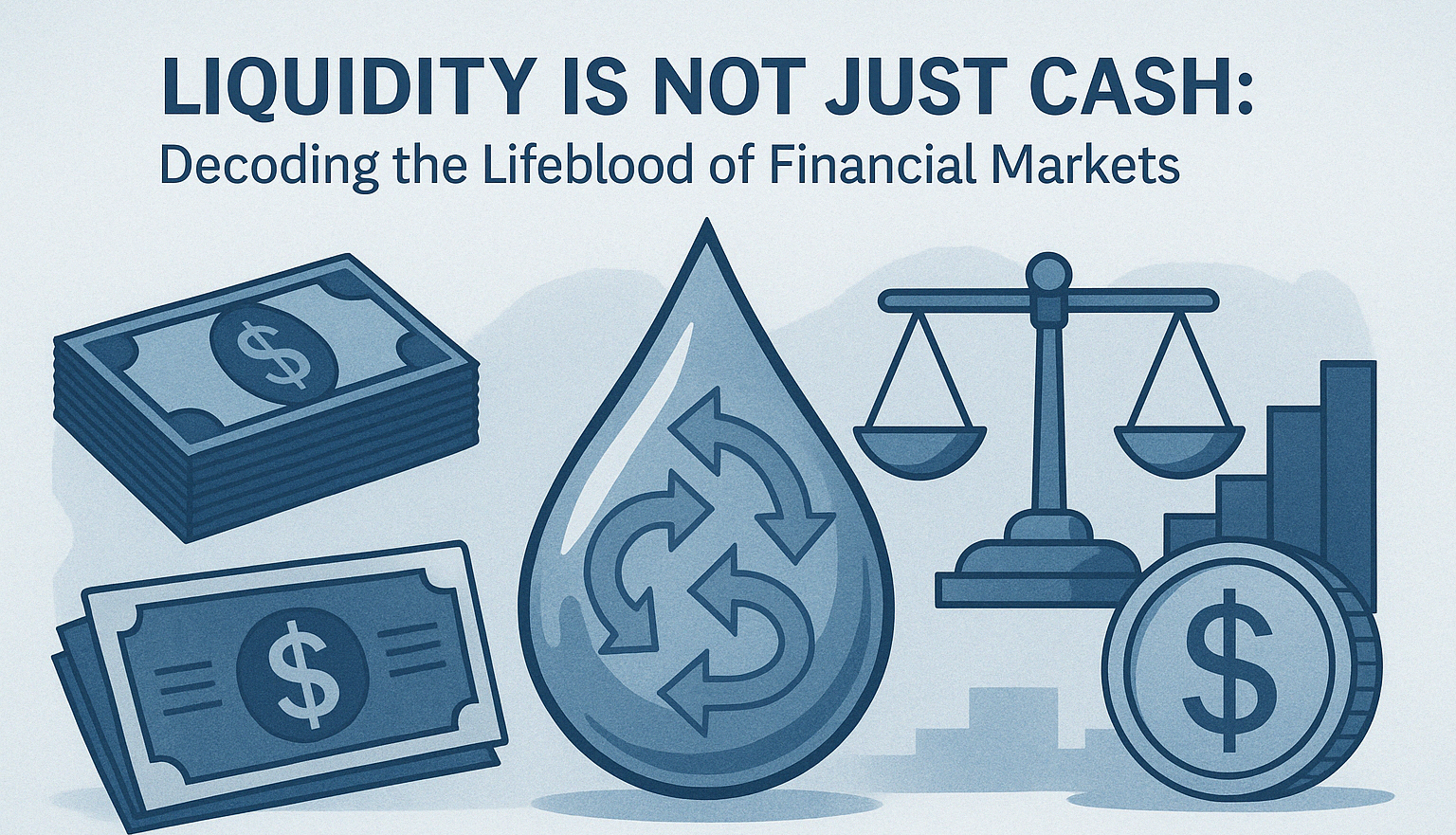
Liquidity Is Not Just Cash: Decoding the Lifeblood of Financial Markets
Liquidity is often described as the lifeblood of financial markets, and this metaphor holds true in practice. It refers to the capacity of the financial system to absorb trades and transactions smoothly essentially, how easily assets can be bought or sold without causing significant price disturbances. While many equate liquidity simply with cash on hand, in reality it encompasses a broader spectrum of assets and funding sources that keep markets functioning. From readily marketable securities to lines of credit, liquidity provides the vital flow that prevents markets from seizing up. Its importance cannot be overstated: even fundamentally sound institutions can be brought down by a liquidity crunch if they are unable to roll over funding or sell assets to meet short term obligations. This article decodes what liquidity truly means beyond just cash, examines its critical role in market stability, and discusses how policy frameworks strive to maintain liquidity in normal times and during crises.

Navigating the AI Anxiety Era: Disruption, Human Capital, and the Data Dilemma
This article explores the growing phenomenon of AI anxiety, the widespread concern about artificial intelligence’s impact on jobs, ethics, and human relevance. It argues that unlike past technological revolutions, AI poses a unique disruption to cognitive labor, accelerating uncertainty in both high and low skilled industries.

Smart Investing Isn't About Being Right, It's About Protecting Your Capital
Smart investing isn’t about predicting the market or being right all the time, it’s about protecting your capital and staying in the game. The article breaks down how overconfidence, psychological biases, and obsession with being “smart” often lead to costly mistakes, while true long-term success comes from risk management, capital preservation, and building disciplined systems. In investing, survival not ego is the real alpha.

Indonesia, as the largest archipelagic state in Southeast Asia, holds immense renewable energy potential ranging from geothermal and hydropower to solar and wind. Yet despite these natural advantages, the country remains heavily dependent on fossil fuels. To meet its Paris Agreement commitments and achieve the national target of 23% renewable energy in its energy mix by 2025, Indonesia must accelerate its green energy transition through strategic investments, policy reform, and infrastructure development
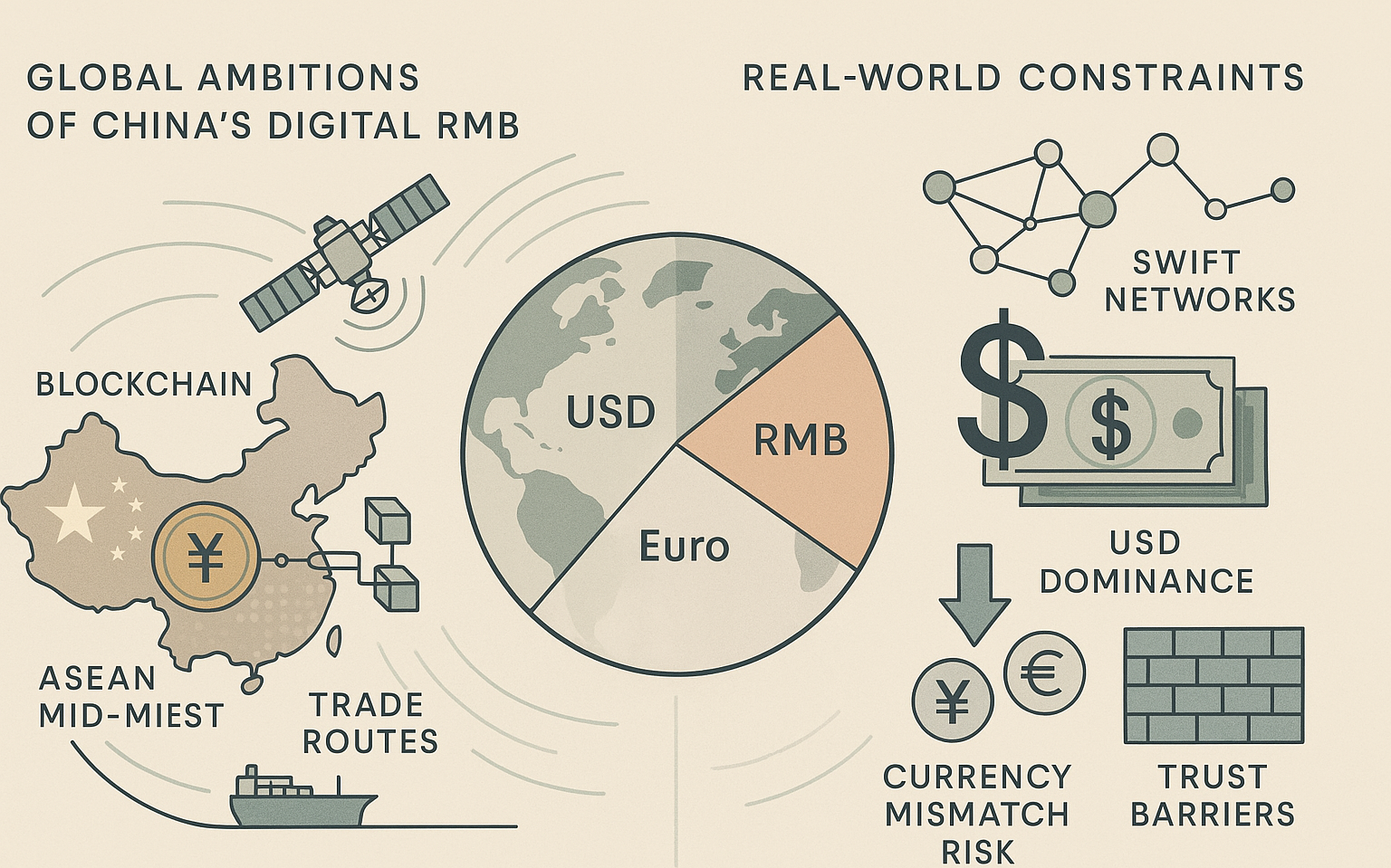
Digital RMB’s Global Ambitions: Promise vs Reality in the Emerging Financial Order
This article explores the strategic expansion of China’s Digital RMB and its implications for the global financial order. It contrasts the promise of faster, de-dollarized, and geopolitically autonomous payments with the entrenched dominance of the USD, trust barriers, and technical limitations. Through the case of Indonesia and global data, it offers a nuanced analysis of how emerging economies can navigate the Digital RMB’s opportunities and risks.
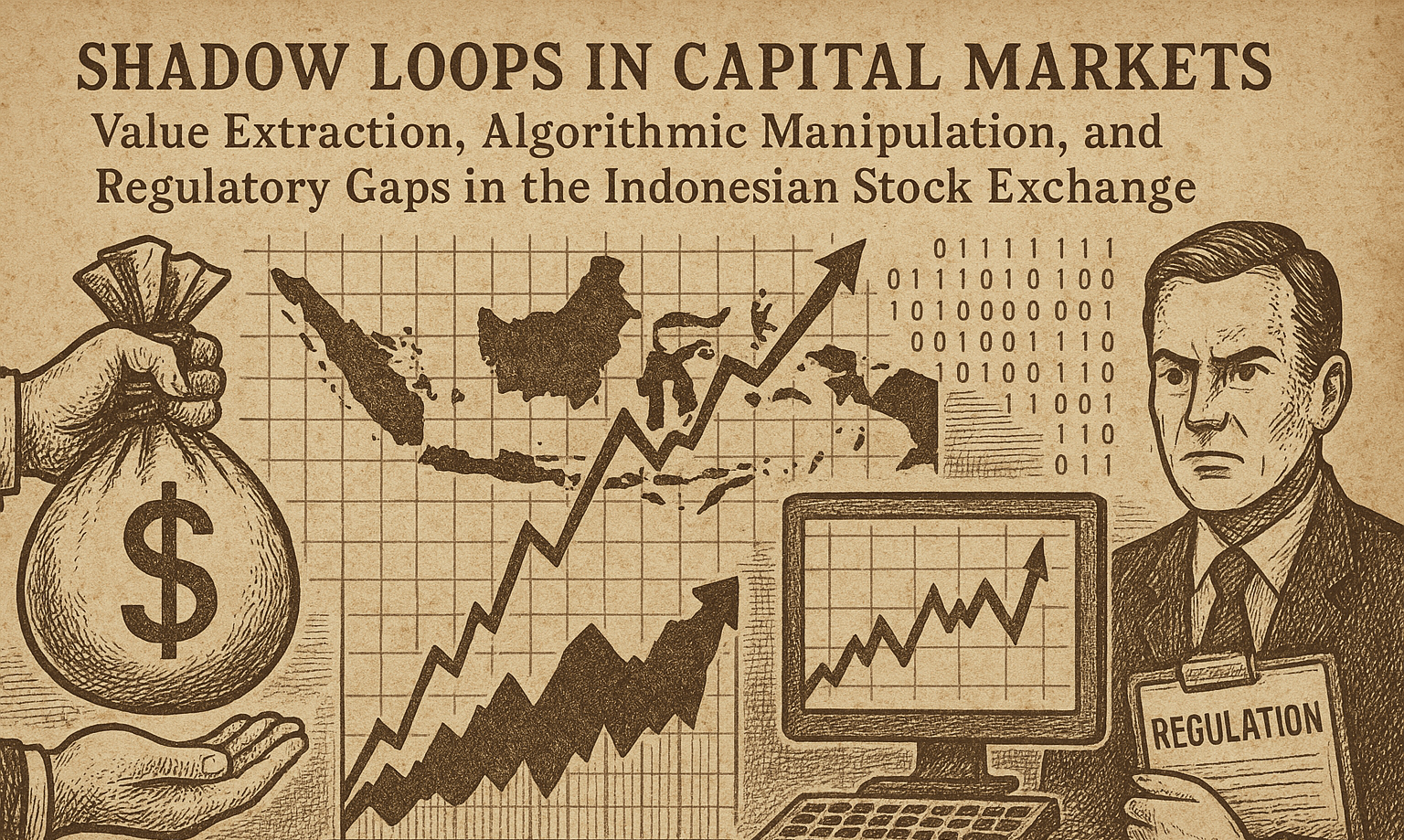
This article dissects the anatomy of systemic value extraction in Indonesia's capital markets through a detailed examination of financial engineering mechanisms that exploit regulatory deficiencies. The Indonesian Stock Exchange (IDX) has become an arena where sophisticated actors manipulate market structures through concentrated shareholding, offshore collateralization, and algorithmic trading strategies. These practices create dangerous feedback loops that disconnect stock valuations from underlying fundamentals, undermine market integrity, and ultimately transform capital markets from engines of economic growth into tools for value extraction. The phenomenon of "saham gorengan" (artificially inflated stocks) is particularly prevalent in low-float securities where price manipulation is facilitated by thin trading volumes and concentrated ownership. By analyzing the structural mechanisms of manipulation, algorithmic trading strategies, and regulatory frameworks, this article identifies critical enforcement gaps and proposes strategic reforms necessary to restore market integrity and realign capital markets with their intended economic purpose. The analysis draws on concrete cases from Indonesia and international markets, including the Jiwasraya scandal, Archegos collapse, and numerous instances of low float manipulation schemes that have severely impacted market integrity.
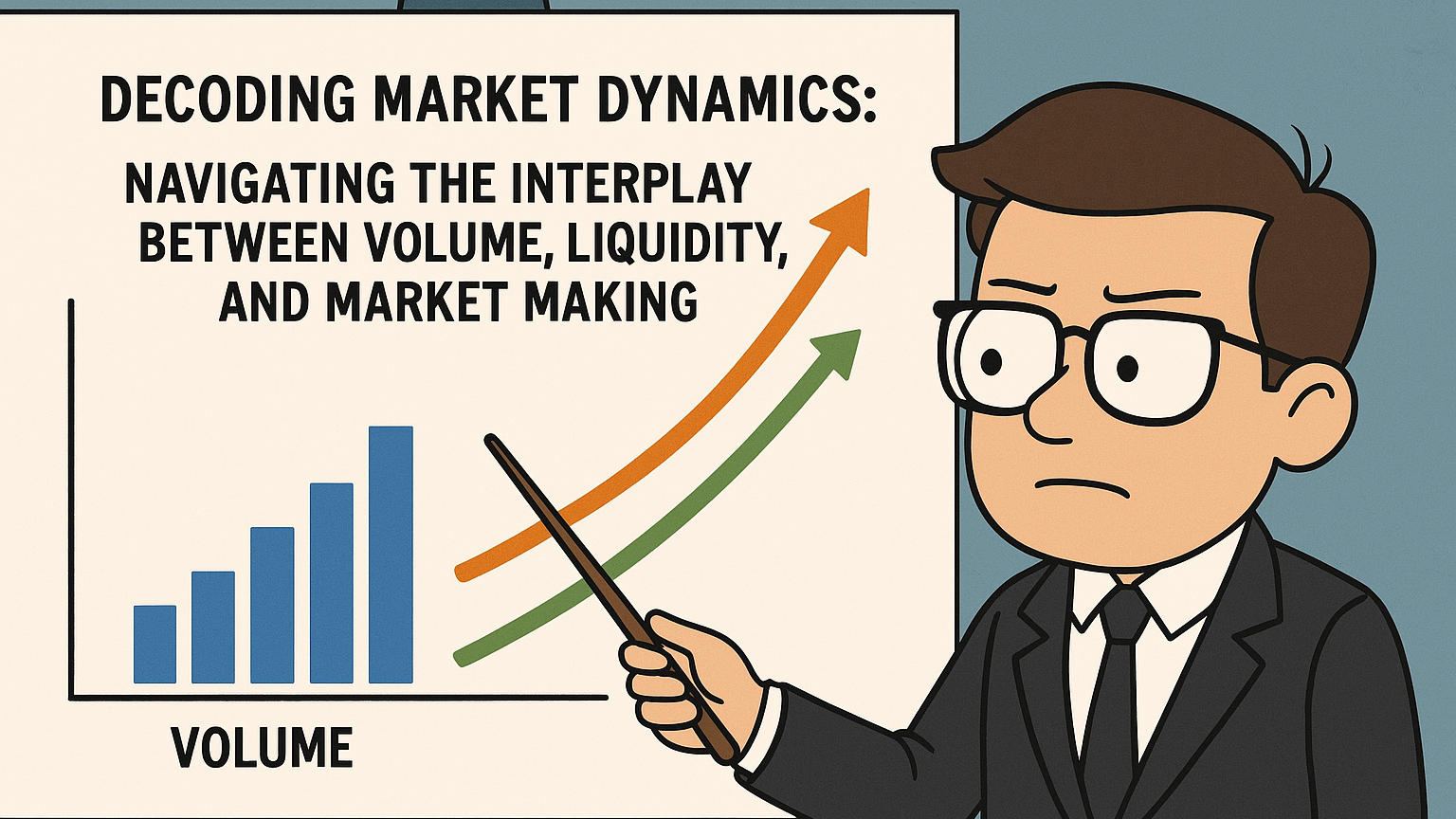
Decoding Market Dynamics: Navigating the Interplay Between Volume, Liquidity, and Market Making
This article explores how the combination of volume and liquidity defines four distinct market environments, and how market makers act as central players in maintaining, exploiting, or stabilizing these conditions. The insights are tailored for traders, analysts, institutional investors, and system designers seeking to understand the microstructure of financial markets from a functional and strategic lens.

Decoding Market's DNA: From Adam Smith to Auction Market and the Value Area
This article examines the intellectual progression from classical economic theory to modern market microstructure analysis, providing a framework for understanding market behavior that goes beyond surface-level technical analysis
This article explores tax forgiveness policies in developing countries, focusing on prominent case studies from Indonesia, Nigeria, and Argentina. It highlights how amnesty programs can generate short term revenue boosts and expand the tax base but often fail to improve long term tax compliance if not accompanied by structural reforms. The paper emphasizes that tax forgiveness whether through amnesties, pardons, or voluntary disclosure should be used as a one time tool within a broader reform agenda, including tax administration modernization, digital infrastructure, and improved governance. Ultimately, tax forgiveness is a policy instrument, not a sustainable fiscal strategy
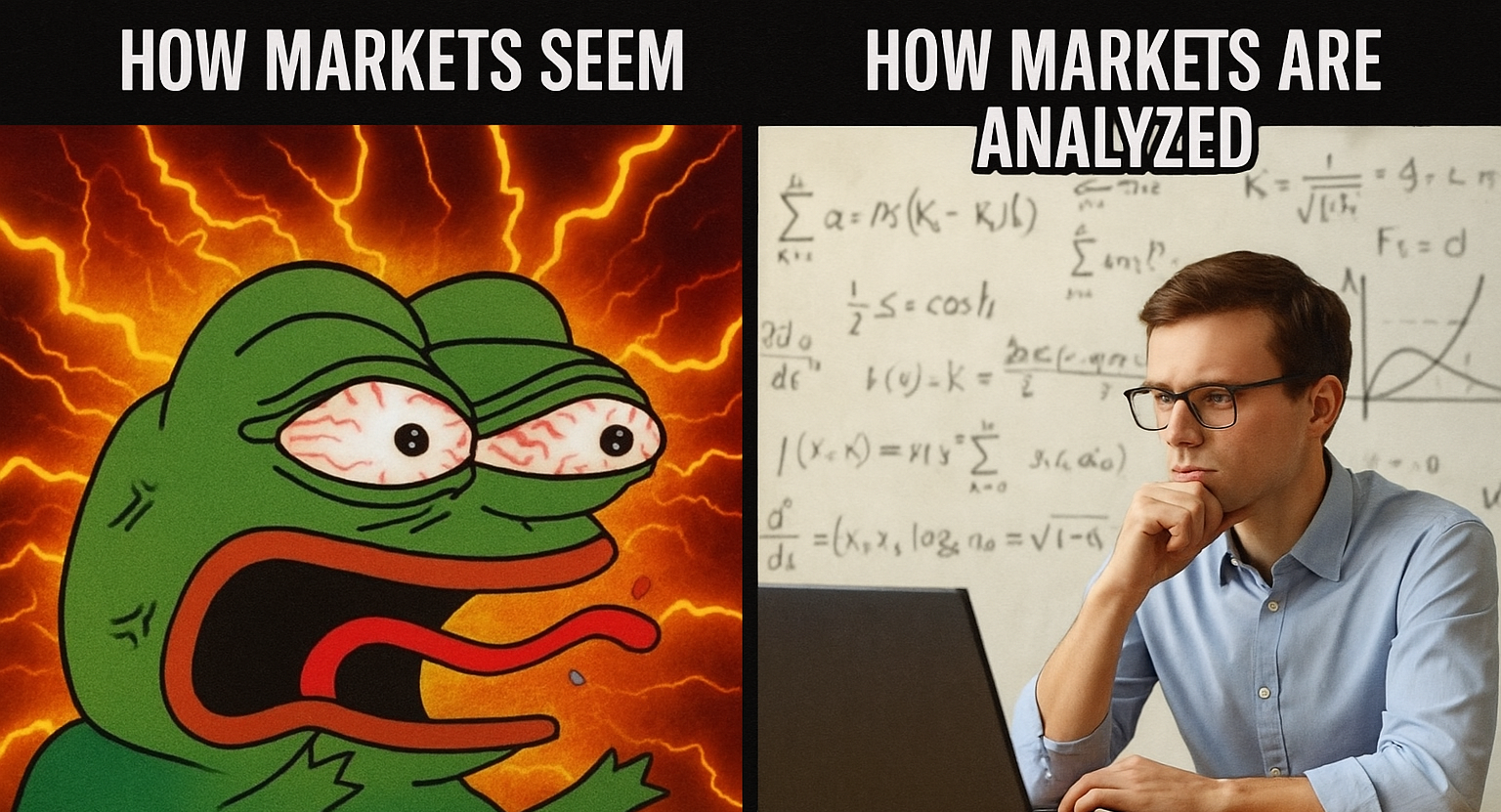
This article explores how a quant trader decodes market movements through data and statistical frameworks rather than emotional narratives or conspiracy theories. It demystifies popular beliefs around market manipulation and introduces four analytical tools regime identification, order flow imbalance, volatility clustering, and liquidity mapping to explain how markets truly operate. A mindset shift from paranoia to pattern recognition is emphasized as the foundation for sustainable trading success.
The Confidence Curve: Why Most Retail Traders Get Played in Every Cycle
This analysis examines the psychological underpinnings of retail trader behavior throughout market cycles, using the Dunning Kruger effect as a framework for understanding the recurring patterns of overconfidence and disillusionment. The research demonstrates how cognitive biases systematically influence market participation, particularly among inexperienced traders, and explains the cyclical rise and fall of market influencers who capitalize on these psychological vulnerabilities. By mapping specific trading behaviors to distinct phases of the Dunning-Kruger curve, this article provides an evidence-based explanation for why retail sentiment follows predictable trajectories during bull and bear markets. The findings suggest that awareness of these psychological patterns can help traders develop more sustainable approaches to market participation and better distinguish between genuine expertise and opportunistic influence. Introduction: The Psychological Architecture of Market Cycles

Shock Into Strategy: Indonesia's Economic Response to the 2025 Global Tariff Escalation
The recent implementation of the United States' universal and targeted tariffs has triggered unprecedented disruption in global trade dynamics, necessitating swift and strategic policy responses from export-oriented economies. This paper analyzes Indonesia's economic exposure to this "Global Tariff Shock 2025" and evaluates potential policy pathways to mitigate negative impacts while strengthening long-term economic resilience. Our analysis indicates that Indonesia's vulnerability extends beyond direct export exposure to the United States (9.8% of exports) to encompass broader systemic risks including global demand contraction, capital flight, and value chain disruptions. Through quantitative modeling and scenario analysis, we demonstrate that a coordinated dual approach combining export market diversification with domestic fiscal stimulus through tax-side interventions offers the most favorable balance of short-term stabilization and long-term resilience. Key findings suggest that reallocating 10-15% of non-mandatory government expenditure toward targeted tax cuts could activate domestic consumption without increasing sovereign debt, while strategic export diversification toward emerging markets could halve projected GDP losses. This paper outlines a comprehensive policy framework to transform external shock into structural opportunity, emphasizing the importance of maintaining Indonesia's strategic economic autonomy in an increasingly fragmented global trade environment.